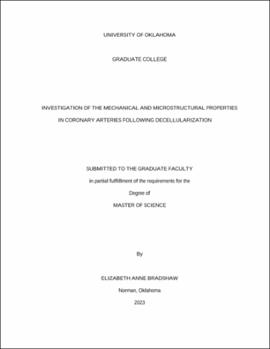| dc.description.abstract | The heart is responsible for pumping blood throughout the body, and like all other
tissues, the heart muscle requires a supply of oxygen-rich blood to function properly. This blood
is supplied by the coronary arteries – the network of blood vessels on the surface of the heart.
There are two main coronary arteries: the left (main) coronary artery and the right coronary
artery. The left coronary artery divides into the left anterior descending artery (LADA) and the
left circumflex artery. The LADA is the largest of the coronary arteries, and it is the most
susceptible to disease. Coronary artery disease is characterized by plaque accumulation on the
inner arterial wall, which limits the blood flow to the heart muscle and can result in a heart
attack. In severe coronary artery disease, surgeons perform a procedure called coronary artery
bypass grafting (CABG), which bypasses the diseased portion of the artery by using a graft to
redirect blood from the aorta to the portion of the artery distal from the blockage. Usually, this
graft comes from another artery within the patient’s body; however, this is not always ideal due
to limited availability of viable vessels and high graft failure rates. When autologous grafts are
unable to be used, a vessel conduit is required, however, current coronary artery conduits are
suboptimal. An alternative approach to tissue-engineered vascular grafts is utilizing a donor
vessel’s native extracellular matrix (ECM) to serve as a scaffold. To minimize the risk of an
immune response from the patient, the donor vessel oftentimes needs to be decellularized to
remove all cellular components. While decellularization remains a promising approach, there is
not a standardized decellularization method for coronary arteries, and there is a lack of research
investigating how the microstructure behaves under pathologic loads following decellularization.
This thesis addresses this gap by proposing a novel protocol for the decellularization of porcine
coronary artery tissue that effectively removes cellular components, while retaining the native
tissue structure and function. This decellularization protocol consists of several treatments using
detergents, enzymes, and rinsing steps, and the removal of cells is confirmed using histology and
microscopic evaluation. To further determine the effect of this decellularization procedure on the
mechanical properties and collagen fiber architecture, biaxial mechanical testing and polarized
spatial frequency domain imaging (pSFDI) were performed before and after decellularization.
This investigation revealed minimal alteration to the mechanical and microstructural properties.
The findings of this thesis will be valuable to the refinement of coronary artery tissue grafts,
which may ultimately improve suboptimal outcomes in coronary bypass surgeries. | en_US |

